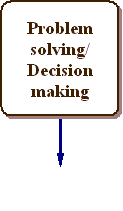Kiosk
We solve problems
and make decisions everyday/all the day |
Problem solving series
Problem Solving and Decision Making
Project planning/organizing class projects
We solve problems and make decisions
everyday/all the day:
at home, at work, at play,
even at the grocery store!
Some problems and decisions are very challenging,
and require a lot of thought, emotion, and research.
The steps of this guide are designed to help you make
good decisions
Good luck!

Flexibility
This procedure looks as if one moves neatly from step to step. This isn't the case. These steps simply provide a structure for working on the problem.
They overlap: you may have to return to earlier
steps, or work them simultaneously,
to find the best solution.
Examples of flexibility:
- Information gathering occurs in all steps—from recognition of the problem to implementation of its solution
- New information may force you to redefine the problem
- Alternatives may be unworkable, and you'll have to find new ones
- Some steps may be combined or abbreviated
 Website overview:
Kiosk guides for learning are a freely accessible educational environment that offers strategies to recognize and realize learning objectives. We accept individual differences without regard to ability and creed; sexual and affectional orientation; caste, tribal and national affiliation; individual, familial and collective history. Our suggestions should be thoughtfully considered for appropriateness and guidance to your situation, relying on elders, mentors, cohorts and/or professionals to achieve learning objectives and outcomes.
Website overview:
Kiosk guides for learning are a freely accessible educational environment that offers strategies to recognize and realize learning objectives. We accept individual differences without regard to ability and creed; sexual and affectional orientation; caste, tribal and national affiliation; individual, familial and collective history. Our suggestions should be thoughtfully considered for appropriateness and guidance to your situation, relying on elders, mentors, cohorts and/or professionals to achieve learning objectives and outcomes.